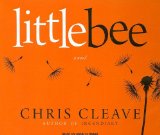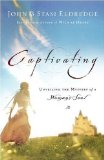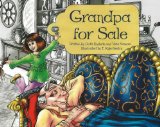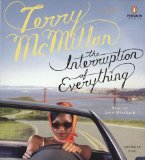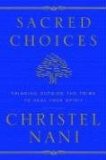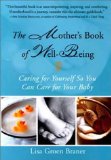 The Mother’s Book of Well-Being
The Mother’s Book of Well-Being
Caring for Yourself So You Can Care for Your Baby
by Lisa Groen Braner
Conari Press, 2003. 181 pages.
Starred Review.
2008 Sonderbooks Stand-out, #7 Nonfiction Personal Growth
Here’s another book I’ve been meaning to review for a very long time. The author was one of our nicest customers at the library on Sembach Air Base in Germany. Again, the time when I moved was a time of upheaval for me, and I got way behind on book reviews. On top of that, this is a book to be read slowly and savored, which I did.
I did give the book to a book-lover friend who was a new mother. She said it brought tears to her eyes and was the best present she got!
The Mother’s Book of Well-Being consists of 52 meditations for each week of your new baby’s life. Each one is only a few pages long, so you ought to be able to get that much reading time in a week! These meditations are not about the baby’s growth, but about your own growth as a woman and as a mother.
In the Prologue, the author says, “That’s where this book picks up — at the point when you can’t possibly go one more moment without sleep, without a shower, without a smidgen of the life you once lived. This is a time of celebration, and also one of healing and learning. When you gave birth to your baby, you also gave birth to yourself as a mother. You’re responsible for another soul and, unexpectedly, newly responsible for yourself.
“The passage from woman to mother is complex. It causes us to reexamine who we are and who we want to be for our children. The ‘guard’ of generations has changed. Becoming a mother suddenly places you in the seat of true adulthood. My feet dangle from that chair often. I hasten to touch the ground and sit up straight in my newfound responsibility. Motherhood is a role in which it takes time to become comfortable and confident. The changes are great and the expectations high. We live in a culture that reveres and elevates motherhood to a superhuman stature. So often we come to the role with perceptions of how it will be, and realize how unprepared we really are. All of the plans you made for yourself and your baby before you gave birth may be hard to take during this time of recovery. This may be the first time you’ve ever been ‘called’ to devote yourself to a job so unconditionally. Some moments will find you strong and tireless, and others will find you exhausted and unsure.
“Be gentle with yourself. You are not alone.”
The weekly chapters have gentle meditations that remind you to look after yourself. Sometimes, they refer to your baby’s growth, as in this passage from Week 30:
“Too often, we miss the sanctity of the present. The present usually arrives peacefully, offering itself as a refuge over and over again while we sit muddled in our minds. We might believe that our thoughts are productive or even interesting, but we’re really ignoring the gift of the day before us.
“This is where our children can teach us. Babies absorb the world around them, touching, tasting, and seeing. They delight in their senses, enjoying the unexpected swoop of a robin or the warmth of the sun emerging from a cloud. Let’s suspend our thinking for a change, return to the simple and original mind with which we were born. Let’s immerse ourselves in the river of the senses — to drift, swim, and float in the day.”
In Week 3, she encourages mothers to find some time to ourselves, somehow.
“Babies tune our hearing outward. We distinguish between cries of hunger and cries of fatigue. We listen for them while we’re awake and asleep. Having a baby pulls us outside of ourselves by necessity. But let’s not forget to keep an ear open to the cry of our inner voice too. Finding thime for solitude encourages us to listen to ourselves. In those quiet moments alone, ask yourself what you need to feel nourished. Honor the answers that come. As mothers, we meet our children’s needs a hundred times a day. Let us remember to ask ourselves what we need to feel nurtured at least once a day.”
My favorite chapter is Week 21, “Literary Escape.”
“Do you ever feel housebound? The weather might be whipping outside, or your baby might be sick with a cold. Whatever the condition, the walls of one’s home can become confining at times. Rather than slink through the day, engage your fingertips and mind by opening a book. There must be at least one book on your shelf that has not yet been read. Perhaps there is even an old favorite that begs to be reread.
“I escape often to Italy, France, and Spain, walking the landscapes of each and taking mental notes along the way. I must remember to return to Tuscany when the olives are harvested for oil. I love Provence when the lavender is lush upon the hills. I’d like to drive winding roads again in Andalucia, amidst lemon trees bending ripe with fruit. Mental travelers need not pack diapers, snacks, or car seats. You’re free to travel alone, which is even lighter….
“It’s refreshing to roam the world — plunging into different countries, meeting new people and tasting their cuisine. If walking another step in your home leaves you less than inspired, sashay into a well-told story. The charms of being at home return after sampling new horizons. Books are an open invitation to another place and time. A baby will usually allow you to sneak a few pages throughout the day. Good books lead us to discover that it is not our house that binds us, but rather the dullness of our thoughts. Reading refreshes the mind and the imagination.”
Buy from Amazon.com
Find this review on Sonderbooks at: www.sonderbooks.com/Nonfiction/mothers_book_of_well_being.html
Disclosure: I am an Amazon Affiliate, and will earn a small percentage if you order a book on Amazon after clicking through from my site.

